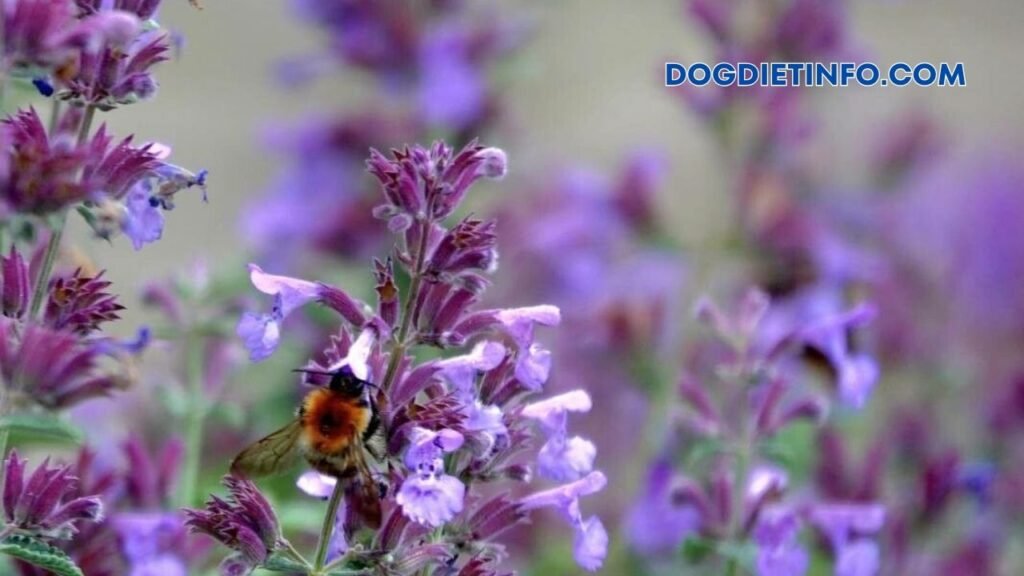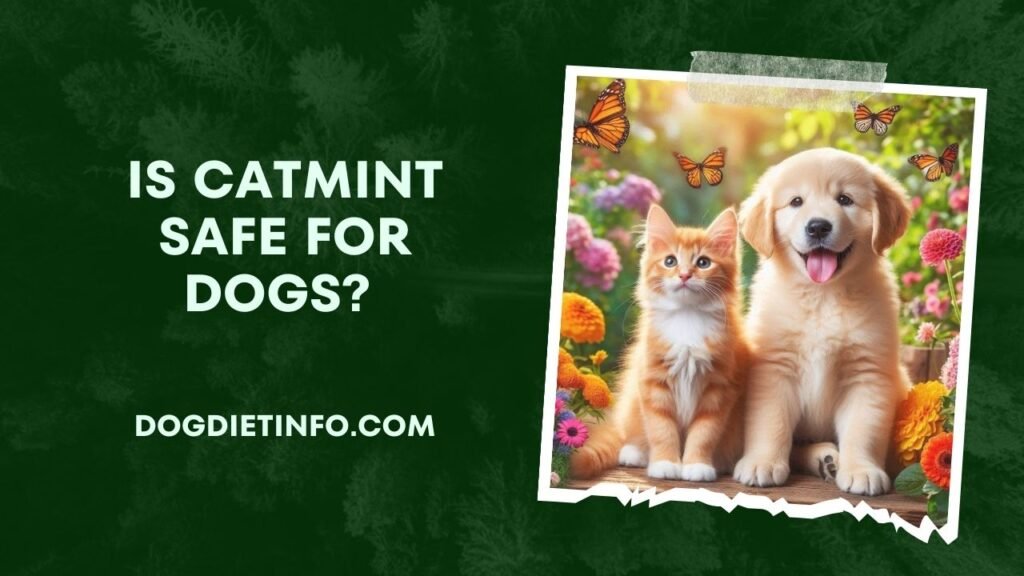Is Catmint Safe For Dogs? Catmint is generally considered safe for dogs when consumed in small amounts, but excessive ingestion can lead to mild gastrointestinal upset.
Catmint, often known for its appeal to felines, is a beautiful addition to gardens and is enjoyed by humans for its aromatic properties and calming effects.
However, if you’re a dog owner, you might wonder whether this seemingly harmless plant poses any risks to your canine companion.
Dogs are naturally curious creatures, and many enjoy exploring the outdoors—sometimes a little too much! If your dog has a habit of munching on plants, it’s crucial to know whether certain greenery, like catmint, is safe for them.
In this article, we will explore whether catmint is safe for dogs, the potential risks it might pose, and how to create a dog-friendly garden that both you and your furry friend can enjoy.
Contents
What Is Catmint?
Description of Catmint
Catmint, scientifically known as Nepeta, is a perennial herb that is closely related to the more commonly known catnip.
It features attractive lavender or pale purple flowers and gray-green foliage, making it a favorite for garden borders and flower beds.
Known for its minty fragrance, catmint is particularly popular among gardeners because of its ease of growth and resilience.
It can thrive in various soil types and withstand drought conditions, which makes it a low-maintenance yet beautiful plant.
Catmint is often confused with catnip, and while they are related, the two are distinct in their effects and appearance. [Is Catmint Safe For Dogs?]
Catnip tends to have a stronger impact on cats, stimulating them to become more active, while catmint has a milder effect, often resulting in a soothing, calming sensation for felines.
Uses of Catmint in Gardens
Aside from its aesthetic value, catmint is beneficial in gardens for several reasons:
- Attracting Pollinators: Catmint’s fragrant flowers attract bees, butterflies, and other beneficial insects, promoting healthy plant growth and pollination.
- Natural Pest Repellent: Catmint is known to deter certain pests, such as aphids and squash bugs, making it a natural way to protect your plants without resorting to chemicals.
- Soothing Fragrance: Its minty, aromatic scent is pleasing to gardeners, adding a relaxing element to outdoor spaces.
Despite its benefits for cats and gardeners, pet owners often question whether it is safe to plant catmint in a yard frequented by dogs.
Is Catmint Safe for Dogs?
Small Amounts vs. Large Amounts
Catmint is generally non-toxic to dogs, which means that small amounts are unlikely to cause serious harm. [Is Catmint Safe For Dogs?]
If your dog happens to take a nibble of the plant, it’s usually not a cause for concern. However, as with many plants, excessive consumption can lead to digestive upset.
While a few bites may pass without issue, dogs that consume large amounts of catmint may experience symptoms like vomiting, diarrhea, and lethargy.
Common Side Effects
If your dog eats too much catmint, the most common side effects are mild and often involve the digestive system. These symptoms may include:
- Vomiting: Dogs may vomit after consuming a large amount of catmint, especially if they are not used to eating plants.
- Diarrhea: Another possible side effect is diarrhea, which can result from irritation to the gastrointestinal tract. [Is Catmint Safe For Dogs?]
- Lethargy: After consuming catmint, some dogs may become unusually lethargic or appear tired. This is likely due to the calming properties of the plant, which are similar to its effects on cats.
While these symptoms are typically mild and resolve on their own, it’s important to monitor your dog closely. If the symptoms persist or worsen, it may be necessary to seek veterinary advice.
Why Dogs Might Be Attracted to Catmint
While catmint is famous for its attraction to cats, some dogs may also find the plant interesting. The strong minty scent and the plant’s soft, green foliage can appeal to a dog’s natural curiosity.
Some dogs might chew on the plant out of boredom or habit, while others might simply enjoy the taste. If your dog is a plant-chewer, it’s important to be cautious about what is accessible in your garden.
When to Be Concerned
While small amounts of catmint are not typically dangerous for dogs, excessive consumption can cause more severe symptoms. If your dog has eaten a large quantity of catmint, be on the lookout for symptoms like:
- Repeated vomiting: If your dog vomits multiple times and is unable to keep food or water down, this could indicate a more serious problem.
- Severe diarrhea: If diarrhea is prolonged or contains blood, contact a vet immediately.
- Extreme lethargy: If your dog becomes unusually lethargic and is difficult to wake, this could be a sign that they are not reacting well to the plant.
- Difficulty breathing: Though rare, some dogs may develop respiratory issues after consuming large quantities of catmint.
If any of these symptoms occur, it’s important to contact a veterinarian for further advice. [Is Catmint Safe For Dogs?]
Preventive Measures
To prevent your dog from overindulging in catmint, consider the following tips:
- Plant Placement: If you still want to enjoy the beauty of catmint in your garden, try placing it in areas that are difficult for your dog to access, such as elevated pots or behind fences.
- Supervised Outdoor Time: If your dog enjoys being outside, consider supervising them while they explore the garden to ensure they don’t ingest harmful plants.
- Alternatives: Providing your dog with safe, chew-friendly alternatives like toys or dog-safe plants can help deter them from eating garden plants.

What To Do If Your Dog Eats Catmint
Immediate Steps
If your dog has eaten a small amount of catmint, it’s likely not a major cause for concern. [Is Catmint Safe For Dogs?]
Simply monitor your dog for any changes in behavior, such as vomiting, diarrhea, or lethargy. Most dogs will pass the plant without issue.
You can help by making sure your dog has access to plenty of water and, if necessary, a bland diet to soothe their stomach.
When to Contact a Vet
If your dog exhibits more severe symptoms, such as persistent vomiting or diarrhea, or if they seem excessively lethargic, it’s a good idea to contact your veterinarian.
While catmint is not toxic in small amounts, individual dogs may react differently, particularly those with sensitive stomachs or underlying health conditions.
Home Remedies
For dogs with mild symptoms, such as an upset stomach, there are a few home remedies you can try:
- Bland Diet: A simple meal of boiled chicken and rice can help settle your dog’s stomach and provide relief from digestive issues.
- Hydration: Make sure your dog stays hydrated, especially if they’ve been vomiting or have diarrhea.
- Rest: Encourage your dog to rest and avoid strenuous activity until they’ve fully recovered.
Alternatives to Catmint for Dog-Safe Gardens
Dog-Friendly Plants
If you’re concerned about your dog’s safety around catmint, consider planting dog-friendly alternatives that offer similar benefits without the potential risks. Some safe plants for dogs include:
- Lavender: Known for its calming scent, lavender is safe for dogs and adds beauty to any garden.
- Rosemary: This herb is non-toxic to dogs and offers a lovely fragrance, making it an excellent choice for garden borders. [Is Catmint Safe For Dogs?]
- Thyme: Thyme is safe for dogs to eat in small amounts and can be used to create a fragrant and pet-friendly garden space.
Planting Strategies
When designing a pet-friendly garden, consider dividing your garden into zones. Create spaces where your dog can roam freely without access to potentially harmful plants.
Use fences, raised beds, or hanging baskets to keep plants like catmint out of reach, and ensure that the plants your dog can access are safe for them.
Managing Harmful Plants
If you have a mix of safe and potentially harmful plants in your garden, consider how to manage their placement.
You can create physical barriers, such as garden netting or fencing, to keep your dog away from areas where catmint or other toxic plants are growing.
Another option is to train your dog to avoid specific areas of the garden, though this can take time and patience.
Final Verdict
In general, catmint is safe for dogs when consumed in small amounts. However, as with any plant, moderation is key. [Is Catmint Safe For Dogs?]
If your dog has a habit of chewing on plants, it’s essential to monitor their behavior and limit their access to potentially harmful vegetation.
While most dogs will not experience severe symptoms from ingesting small amounts of catmint, larger quantities can lead to gastrointestinal upset and other mild symptoms.
As always, if you notice any unusual behavior after your dog consumes catmint, it’s best to consult your veterinarian for professional advice.
See Also: Is Chewing Gum Bad For Dogs?
FAQs
Can dogs eat catmint leaves?
Yes, small amounts of catmint leaves are generally safe for dogs, but large amounts may cause mild gastrointestinal upset. [Is Catmint Safe For Dogs?]
What should I do if my dog eats too much catmint?
Monitor your dog for symptoms such as vomiting, diarrhea, or lethargy. If symptoms persist, contact your vet for further guidance.
Is catnip the same as catmint for dogs?
Catnip and catmint are related but different plants. While both are generally safe for dogs, catnip tends to have a stronger effect on cats, whereas catmint has a milder impact.
Can catmint be used as a calming herb for dogs?
Catmint does not have the same calming effect on dogs as it does on cats. While some dogs may enjoy the scent, it’s not commonly used as a calming herb for canines.
Are there other plants safer than catmint for dogs?
Yes, plants like lavender, rosemary, and thyme are safer alternatives for dogs and can be incorporated into your garden. [Is Catmint Safe For Dogs?]
Conclusion: Is Catmint Safe For Dogs?
Catmint is a beautiful and versatile plant that offers many benefits to gardens, but dog owners should exercise caution.
While small amounts of catmint are generally safe for dogs, large quantities can lead to mild gastrointestinal issues like vomiting and diarrhea.
By creating a dog-friendly garden and monitoring your pet’s behavior, you can enjoy the beauty of catmint without putting your furry friend at risk.
If your dog shows any signs of distress after consuming catmint, always consult your veterinarian to ensure their safety.

Derrick Wilcox is a certified canine behaviorist with over 12 years of experience at Happy Paws Animal Clinic and Pawsitive Training Center, helping pet owners ensure safer, healthier, and happier lives for their dogs.



